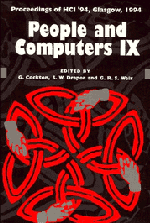Book contents
- Frontmatter
- Contents
- Preface: HCI'94 – You Probably Haven't Seen It All Before
- Part I Invited Papers
- Part II Methodology of Interactive Systems Development
- Crafting Interaction: Styles, Metaphors, Modalities and Agents
- 10 A Comparison of Placement Strategies for Effective Visual Design
- 11 Evaluation of Alternative Operations for Browsing Hypertext
- 12 On the Problem of Selecting Interaction Objects
- 13 Minimising Conceptual Baggage: Making Choices about Metaphor
- 14 Keeping an Eye on your Interface: The Potential for Eye-Based Control of Graphical User Interfaces (GUI's)
- 15 A Linguistic Approach to Sign Language Synthesis
- 16 Generalisation and the Adaptive Interface
- 17 Agent-Based Interaction
- Modelling Humans, Computers and their Interaction
- Notations and Tools for Design
- Part VI Computer-Supported Cooperative Work
- Author Index
- Keyword Index
14 - Keeping an Eye on your Interface: The Potential for Eye-Based Control of Graphical User Interfaces (GUI's)
Published online by Cambridge University Press: 04 August 2010
- Frontmatter
- Contents
- Preface: HCI'94 – You Probably Haven't Seen It All Before
- Part I Invited Papers
- Part II Methodology of Interactive Systems Development
- Crafting Interaction: Styles, Metaphors, Modalities and Agents
- 10 A Comparison of Placement Strategies for Effective Visual Design
- 11 Evaluation of Alternative Operations for Browsing Hypertext
- 12 On the Problem of Selecting Interaction Objects
- 13 Minimising Conceptual Baggage: Making Choices about Metaphor
- 14 Keeping an Eye on your Interface: The Potential for Eye-Based Control of Graphical User Interfaces (GUI's)
- 15 A Linguistic Approach to Sign Language Synthesis
- 16 Generalisation and the Adaptive Interface
- 17 Agent-Based Interaction
- Modelling Humans, Computers and their Interaction
- Notations and Tools for Design
- Part VI Computer-Supported Cooperative Work
- Author Index
- Keyword Index
Summary
This paper examines the issues surrounding the use of an eyetracker, providing eye-movement data, as a general purpose input device for graphical user interfaces. Interacting with computers via eye-movements is not in itself new, however previous work in the area has been directed towards interaction with purpose-built software which can take into account device limitations such as accuracy. This work investigates how one can interact with unmodified graphical interface software which normally requires mouse and/or keyboard input. The results of three experiments are discussed which have compared performance between the eyetracker and the mouse, and between different ways of emulating mouse button presses using the eyetracker data. The experiments as a whole consider a range of tasks from simple button presses to the more complex and demanding operations of selecting text, and they indicate the feasibility of using the eyes to control computers.
Keywords: physically-challenged, eye-control, input device.
Benefits of Controlling Graphical User Interfaces by Eye
Overview
The use of the eyes as a primary means of controlling input is appealing for a number of reasons.
First, it can be considered as a ‘natural’ mode of input and by-passes the need for learned hand-eye co-ordination to effect operations such as object selection. The user simply looks at a screen object they wish to select rather than using a hand-held pointing device, such as a mouse, to position a screen cursor over the object.
Second, one can expect performance benefits. If a user need only look at an object to acquire it, rather than having additionally to control and position a cursor by hand, speed of selection will be increased.
- Type
- Chapter
- Information
- People and Computers , pp. 195 - 210Publisher: Cambridge University PressPrint publication year: 1994
- 1
- Cited by



